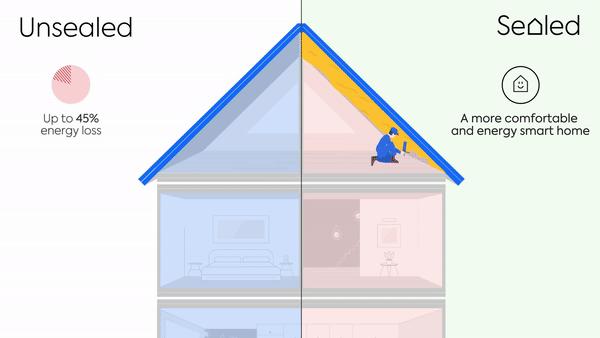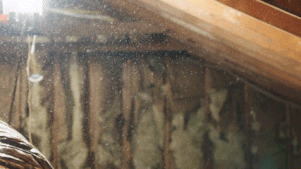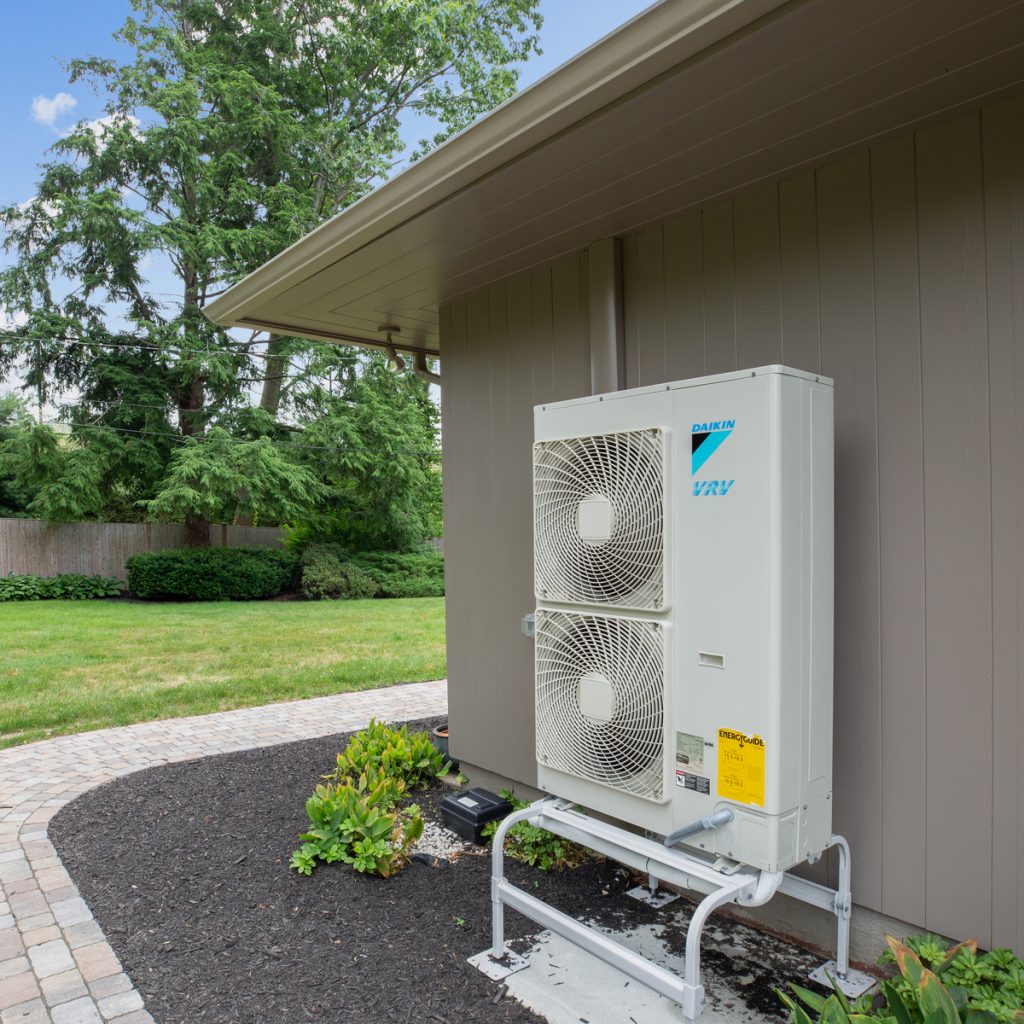Poor ventilation can be a sneaky problem, quietly causing havoc without any obvious signs.
When you throw the term comfortable home into Google search, you get a lot of images of… comfy stuff: puffy pillows, throw rugs, and wall hangings.
Sure, all of these things are important (as well as aesthetically pleasing), but when it comes to home comfort, it’s usually the factors you don’t see that make the most difference in how your home feels. And good home ventilation is at the top of that list.
But ventilation isn’t just about comfort. Poor room ventilation can have health implications, including poor air quality, mold growth, and even respiratory issues (1).
So what is good home ventilation? And how do you increase or repair your home’s ventilation if you need to? You’re in the right place. We’re Sealed, and we can help. As energy efficiency and home upgrade experts, we’ve seen it all.
Plus, depending on where you live, you could get your home’s ventilation and comfort issues fixed—eligible rebates and an energy-saving guarantee included. Tap here to see if you qualify.
Table of contents:
- What is good home ventilation?
- Signs of poor ventilation
- What causes poor ventilation in a house?
- The best way to improve home ventilation in a room immediately
- How to ventilate a room
- When to call a pro to help with home ventilation issues
- How to get home comfort upgrades with guaranteed results
What is good home ventilation? How do you make sure you have it?
So just what is “good home ventilation”? Basically, it’s the process of bringing fresh, clean, good-smelling air into your living space while removing stale, moist, stuffy-feeling or contaminated air.

When a house is well ventilated, it will feel fresh, smell fresh, and have the perfect level of humidity.
In short: A well-ventilated house feels great—like a perfect spring day.
Bonus? A well-ventilated and correctly ventilated house wastes less energy, too.
Achieving good home ventilation requires a strategy based in science.
And it often includes exciting home-improvement tools like soffits, attic baffles, spray foam, caulk, correctly-vented bathroom fans, stove fans, and dryer vents, duct sealing, and more.
(Okay, maybe caulk and dryer vents aren’t exciting to you, but we kinda nerd-out on them.)
How do you know if your house has poor ventilation?
Poor ventilation can be a sneaky problem, quietly causing havoc without any obvious signs. In fact, the signs of bad airflow often masquerade as minor annoyances that you just learn to live with—not realizing they signal a deeper issue.
So here’s a quick list of the signs of bad ventilation:
- Lots of persistent, unpleasant smells
- Out-of-control indoor humidity
- Deteriorating air quality
- Mold growth
- Excess condensation
- Dust everywhere
- A stuffy-feeling house
The signs of poor ventilation often masquerade as minor annoyances that you just learn to live with—not realizing they signal a deeper issue.
1. Lots of persistent, unpleasant smells
The aroma of a home-cooked meal is delightful—until it lingers for days. If your home consistently smells like last night’s dinner, or if a musty, stale odor permeates your living space, this could be a symptom of insufficient ventilation.
A working ventilation system should cycle out stale air and bring in fresh air, reducing and getting rid of odors over time. If that isn’t happening in your home, that’s a sign your ventilation isn’t working well.
2. Out-of-control indoor humidity
In summer, does it feel like you’re living in a rainforest? With dense, heavy, moist air? That’s a big indication that your home’s ventilation needs attention. (Learn more about maintaining healthy home moisture levels.)
Proper ventilation means circulating and dehumidifying the air inside your home. When that system is compromised, excess moisture tends to accumulate, making your indoors feel uncomfortably… moist.
This is an issue you definitely want to fix, since high indoor humidity can encourage mold and mildew growth, damaging your home and potentially causing health issues (2).
3. Deteriorating air quality
If you find yourself reaching for a tissue more often due to constant sneezing, or you experience frequent bouts of respiratory discomfort, don’t blame it on the changing weather right away. Poor ventilation can result in a buildup of indoor pollutants like dust, pet dander, and other allergens. Yuck.
Poor ventilation can result in a buildup of indoor pollutants like dust, pet dander, and other allergens. Yuck.
4. Mold growth
If the air isn’t circulating well in your home, it creates an ideal environment for mold and mildew. That’s just as bad for you as it is for your house (3).
Mold and mildew are like unwanted house guests—they show up uninvited and are tough to kick out. If you’re starting to see mold growth, especially in areas that aren’t typically damp, you need to look at your ventilation system—pronto.
5. Excess condensation
Your windows and walls might be trying to tell you something. If you frequently notice condensation on these surfaces, that’s a good sign that your AC and ventilation systems are struggling.
6. Dust everywhere
A little dust is normal. But if you’re in a constant battle with dust, that’s a sign of a bigger problem.
If your home’s air circulation is not up to par, dust particles tend to linger in the air and settle on surfaces. A well-ventilated home should keep these dust particles in check—which means you won’t have to pull out the duster every day.

7. A stuffy-feeling house
Finally, how do you feel in your home? Is there a lot of hot air that just never moves? If your house always feels stale or stuffy or sticky—that’s a pretty good sign that something has gone wrong with your ventilation system.
Either your HVAC system isn’t circulating enough fresh, clean, dehumidified air or too much outside air is getting inside your house. (Or both!)
Those are the big signs. Recognize any of them? If so, there’s good news: These issues will either resolve completely or get a lot better once you fix your ventilation problem.
But that brings up another question: Why is your ventilation struggling in the first place?
What causes poor ventilation in a house?
The easiest way to answer this question is to talk about what’s necessary for good ventilation. (Buckle up. Lots of factors are necessary to keep your home’s air moving in a healthy manner.)
Here’s what your house needs for good ventilation:
- Efficient, properly-sized HVAC
An HVAC system that’s the right size and works efficiently will keep the air circulation going smoothly.
If your HVAC is too small, poorly maintained, or too old to work correctly, the ventilation in your house is going to be pretty poor. - An effective thermal barrier
A thermal barrier (also called a thermal boundary) is just a fancy term for the insulation and air-sealing components in a home that help keep outside air out and indoor air in.
When your home has a solid thermal barrier, it helps maintain consistent temperatures and reduce drafts, making your HVAC’s job easier, extending the lifespan of your heating and cooling systems, and improving overall ventilation. - Sufficient air exchange
Homes require a delicate balance when it comes to exchanging indoor air for fresh, outdoor air. Too much air leaking inside or not enough air exchanging can result in stuffy, stale, or humid conditions.
(This is a pretty complex topic, but the simplest way to think about air exchange is that you want to be able to control your house’s air intake. You don’t want a lot of accidental air exchange from gaps in the house or insufficient insulation!) - Clean, functional ductwork
The ducts in your home are responsible for transporting the air from your HVAC system throughout your living space. If your ducts are dirty, clogged, or poorly designed, it can significantly hinder the flow of air and negatively affect your ventilation.
Regular duct cleaning and maintenance are essential to ensure that your home remains well-ventilated and comfortable. (Read more about ductwork here.) - Proper venting and exhaust fans (especially in the bathroom and kitchen)
Ensuring that your kitchen and bathroom have direct venting to the outside is also pretty important. That’s because these rooms, like the kitchen and bathroom, tend to generate a lot of moisture and odors.
Having proper venting and exhaust fans in these spaces ensures that excess moisture, smells, and harmful smoke are evicted from your home quickly so they don’t contribute to overall poor air quality.
Here’s a quick video to explain the process:
(Read: How to make sure your air is healthy and clean?)
If you’re thinking, “Hey, those are a lot of factors to pay attention to!”—you’re right. And that’s not great news. If any of the above systems go wrong, it can seriously affect your home’s ventilation and air quality.
The good news? You can take active steps to make your home ventilation better. Let’s look at those now.
What is the best way to improve home ventilation in a house immediately?
Is the situation dire? Got it. Let’s quickly talk about some steps you can take to improve your home’s ventilation situation right now. (We’ll assume your ceiling fans are already on full blast.)
- Change the air filter in your air conditioning system
Ever tried breathing through a dirty sock? Obviously not. But that should give you a pretty good mental image of what your home’s air circulation system has to do if you don’t change the filters regularly. - Make sure all the vents are open
This may seem too obvious, but vents have a funny way of mysteriously closing. (The most prominent theory in the HVAC community is ghosts, but data is still outstanding.) In any case, if one room in your house suddenly gets stuffy, it can’t hurt to do a quick vent check. - Clean supply and return vents
While you’re looking at vents, bring along the cleaning supplies. You don’t have to be a duct professional to see the condition of the vents (or registers) in your home, and if they look gross—or are full of your toddler’s crayons—that’s a good indicator that they need a cleaning. - Get your ducts professionally cleaned
This one may or may not be effective, but it’s worth including because sometimes getting the ductwork in your house scrubbed out can help move more air. Note that this won’t help if your ducts are leaking air. (Learn more about ductwork and when it’s worth it to call in the duct cleaners or duct sealers.) - Look for air gaps in your house
Too much unwanted air exchange with the outside can really kill your home’s air movement. Tap here for directions for looking for air leaks in your house (so you can seal them up). - Opening windows
Natural ventilation, anyone? It’s a last resort—and it won’t work comfortably on hot, muggy summer days. But if it’s truly miserable inside your house, and it’s cool and breezy outside… you know what to do.
How to permanently fix the ventilation in your house
While the above tips can provide immediate relief in some cases, for most folks they’re more like using a Band-Aid to fix a flat tire: You might get a few more feet down the road, but ultimately you’ll end up right back in the same situation.
So how do you increase ventilation in your house? More to the point: What do you need if you want a perfectly comfortable and perfectly permanent fix to your house’s ventilation woes?
The short answer: You need a ventilation strategy. That is, a multi-faceted plan—designed by an expert—for a whole-house ventilation system that’s perfectly tailored to your home’s specific needs.
As you’ve seen, there are a lot of systems that contribute to your home’s airflow and indoor air quality (or lack thereof).
And if you want to see your ventilation issues gone for good, you need to call in an expert to look at your house, diagnose your challenges and ventilation options, and then do some (or all) of the following:
- Seal your home: Your house is full of tiny holes and gaps that let a whole lot of outside air in—and that makes it pretty hard for your AC and ventilation systems to do their job. When you get your home professionally air sealed, an expert will come into your home and close up those air gaps and holes (so that the outside stays outside). Learn more about air sealing here.
- Upgrade your insulation: If you have an under-insulated house, you might be surprised at how much unwanted heat and outside air is seeping in—especially through the top of your house via the attic. An expert can take a look, determine the situation, and recommend the best combination of insulation to stop that problem completely. Learn more about insulation here.
- Fix the venting and exhaust fans: It’s crucial for the health of your home to vent out impure, smoky, or overly-humid air from your bathroom and kitchen. And making sure these systems are working correctly is even more important for your health—especially given the new information we have about gas stoves and natural gas safety.
- Upgrade your HVAC system: Sometimes there’s no getting around it—you very well might need new AC (especially if yours is older than your favorite Grateful Dead t-shirt). The good news here is that modern air conditioning systems are amazing—especially the high-efficiency, highly-comfortable heat pump. (Yes, it has heat in the name, but it’s a tremendous air conditioner as well as a heater. See the benefits of heat pumps for yourself by tapping here.)
Ultimately, a whole-home heat pump can handle air circulation throughout your entire house, providing cooling, dehumidification, and air filtration—all in one system. And all for way less energy. Houses cooled by heat pumps are like a breath of fresh air, without any loud noises or smells. (You can get one installed by experts here.)

A whole-home heat pump can handle air circulation throughout your entire house, providing cooling, dehumidification, and air filtration—all in one system.
Now, hiring an expert, figuring all this out, and making an upgrade plan might very well sound intimidating. After all, who really wants to wrangle contractors or check reviews or manage your huge home upgrade project?
Well, we do. We’ll do all of the difficult stuff for you.
Even better? We’ll guarantee the results. Read on.
Get your ventilation issues solved by experts. Results guaranteed.
Upgrading your home is complex and stressful, and making sure it’s done right the first time can be a headache.
That’s where Sealed comes in. With Sealed…
- The whole upgrade process is hassle-free. We make the whole-home comfort upgrade process hassle-free—including flexible payment options.
- We’ll do the heavy lifting and paperwork. We vet the best home performance contractors in your area, and match you with the right one based on their expertise and the unique needs of your house.
We meticulously research what upgrade rebates your project might be eligible for—and lead the way in helping you understand what’s available. - The upgrades will work. Your house will become a comfortable, energy-efficient marvel. (Or we’ll pay you back.) You get to sit back and enjoy hassle-free home upgrades that make your house feel better year round and fix your ventilation issues for good.
Fill out our quick questionnaire to see if your house qualifies to work with Sealed and our famous Sealed energy-saving guarantee.